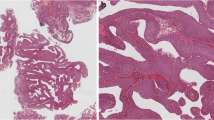Abstract
Bladder carcinoma is most common urological malignancy in Pakistan. The objective of the study was to determine the clinico-pathological characteristics of histologically confirmed bladder carcinoma at a tertiary care hospital of South Punjab, Pakistan. Methods: In two hundreds and twenty one patients (172 male and 49 female) bladder carcinoma was diagnosed from Jan 1998 to June 2005. All patients were evaluated with regards to clinical presentation, cystoscopic findings and histo-pathological data. Results: Male female ratio was 3.5:1. The median age was 58 years (range 18–87 years). 65% men had history of cigarette smoking while 51% women had long history of smokeless tobacco (nasal snuff or chewable) use. Most patients presented with painless hematuria. Primary transitional cell carcinoma was the most common (i.e. 96%) histological variety of bladder carcinoma. 63% patients had muscle invasive disease at the time of presentation. Even in superficial bladder carcinoma, most patients had invasion of lamina propria (pT1 disease). Conclusion: More than 90% of primary bladder carcinoma are of transitional cell variety and over 60% having muscle invasive disease at the time of diagnosis. Even in patients with superficial disease, majority (i.e. 98%) have invasion of lamina propria.
Similar content being viewed by others
References
N Sengupta E Siddiqui FH Mumtaz (2004) ArticleTitleCancer of the bladder J R Soc Health 124 228–229 Occurrence Handle15493783 Occurrence Handle1:STN:280:DC%2BD2critlehsg%3D%3D
F Rabbani C Cordon-Cardo (2000) ArticleTitleMutation of cell cycle regulators and their impact on superficial bladder cancer Urol Clin North Am 27 83–102 Occurrence Handle10696248 Occurrence Handle1:STN:280:DC%2BD3c7mtFagug%3D%3D Occurrence Handle10.1016/S0094-0143(05)70237-8
N Zebic S Weinknecht D Kroepfl (2005) ArticleTitleRadical cystectomy in patients aged more than 75 years: an updated review of patients treated with curative and palliative intent BJU Int 95 1211–1214 Occurrence Handle15892803 Occurrence Handle10.1111/j.1464-410X.2005.05507.x
R Lee MJ Droller (2000) ArticleTitleNatural history of bladder cancer: implications for therapy Urol Clin North Am 27 IssueID1 1–14 Occurrence Handle10696240 Occurrence Handle1:CAS:528:DC%2BD3cXktFSltrg%3D Occurrence Handle10.1016/S0094-0143(05)70229-9
BR Konety RD Williams (2004) ArticleTitleSuperficial transitional (Ta/T1/CIS) cell carcinoma of the bladder BJU Int 94 18–21 Occurrence Handle15217424 Occurrence Handle10.1111/j.1464-410X.2003.04894.x
R Madeb EM Messing (2004) ArticleTitleGender, racial and age differences in bladder cancer incidence and mortality Urol Oncol 22 IssueID2 86–92 Occurrence Handle15082003
M Rafique AA Javed (2004) ArticleTitleRole of itravenous urography and transabdominal ultrasonography in the diagnosis of bladder carcinoma Int Braz J Urol 30 IssueID3 185–191 Occurrence Handle15689243 Occurrence Handle10.1590/S1677-55382004000300002
W Stackl M Baierlein W Albrecht (1998) ArticleTitleBladder preservation in muscle – invasive bladder cancer BJU Int 82 357–360 Occurrence Handle1:STN:280:DyaK1cvks1SntQ%3D%3D Occurrence Handle10.1046/j.1464-410X.1998.00750.x
JWF Catto M Meuth FC Hamdy (2004) ArticleTitleGenetic instabilitry and transitional cell carcinoma of the urinary bladder BJU Int 93 19–24 Occurrence Handle14678361 Occurrence Handle1:CAS:528:DC%2BD2cXhtVSjurw%3D Occurrence Handle10.1111/j.1464-410X.2004.04548.x
AF Olumi EC Skinner YC Tsai PA Jones (1990) ArticleTitleMolecular analysis of human bladder cancer Semin Urol 4 270–277
AJ Sasco MB Secretan K Straif (2004) ArticleTitleTobacco smoking and cancer: a brief review of recent epidemiologic evidence Lung cancer 45 IssueIDsuppl 2 S3–S9 Occurrence Handle15552776 Occurrence Handle10.1016/j.lungcan.2004.07.998
RD Burch TE Rohan CR Howe et al. (1989) ArticleTitleRisk of bladder cancer by source and type of tobacco exposure Int J Caner 44 622–628 Occurrence Handle1:STN:280:By%2BD3cjnsVw%3D
DT Silverman P Hartge AS Morrison SS Devesa (1992) ArticleTitleEpidemiology of bladder cancer Hematol Oncol Clin North Am 6 IssueID1 1–30 Occurrence Handle1556044 Occurrence Handle1:STN:280:By2B3M%2FksFM%3D
SE Alam (1998) ArticleTitlePrevalence and pattern of smoking in Pakistan J Pak Med Assoc 48 IssueID3 64–66 Occurrence Handle9783029 Occurrence Handle1:STN:280:DyaK1cvls1emug%3D%3D
PMRC National Health survey of Pakistan. Network publication services 1998
JN Eble RH Young (1997) ArticleTitleCarcinoma of the urinary bladder: a review of its diverse morphology Semin Diagn Pathol 14 98–108 Occurrence Handle9179971 Occurrence Handle1:STN:280:ByiA38zlt1c%3D
DM Wallace RT Bryan JA Dunn et al. (2002) ArticleTitleDelay and survival in bladder cancer BJU Int 89 868–878 Occurrence Handle12010230 Occurrence Handle1:STN:280:DC%2BD383ntV2juw%3D%3D Occurrence Handle10.1046/j.1464-410X.2002.02776.x
GN Gephardt PB Baker (1995) ArticleTitleInter-institutional comparison of bladder cancer surgical pathology report adequacy. A college of American Pathologists Q-probes Study of 7234 bladder biopsies and cuttings in 268 institutions Arch Pathol Laboratory Med 119 681–685 Occurrence Handle1:STN:280:ByqA2svjtFU%3D
EM Messing TB Young VB Hunt et al. (1995) ArticleTitleComparison of bladder cancer outcome in men undergoing hematuria home screening versus those with standard clinical presentations Urology 45 IssueID3 387–396 Occurrence Handle7879333 Occurrence Handle1:STN:280:ByqC1crgtV0%3D Occurrence Handle10.1016/S0090-4295(99)80006-5
I Leibovitch J Ben-Chaim J Ramon et al. (1993) ArticleTitleThe significance of ureteral obstruction in invasive transitional cell carcinoma of the urinary bladder J Surg Oncol 52 IssueID1 31–35 Occurrence Handle8441258 Occurrence Handle1:STN:280:ByyC1c%2FksFM%3D
Roohullah J Nusrat SR Hamadani et al. (2001) ArticleTitleCa urinary bladder: 5 years experience at Cenar J Ayyub Med Coll Abottabad 13 IssueID2 14–16 Occurrence Handle1:STN:280:DC%2BD3Mnos1Wmtg%3D%3D
Author information
Authors and Affiliations
Corresponding author
Rights and permissions
About this article
Cite this article
Rafique, M., Javed, A.A. Clinico-pathological features of bladder carcinoma: Experience from a tertiary care hospital of Pakistan. Int Urol Nephrol 38, 247–250 (2006). https://doi.org/10.1007/s11255-006-6676-1
Issue Date:
DOI: https://doi.org/10.1007/s11255-006-6676-1



